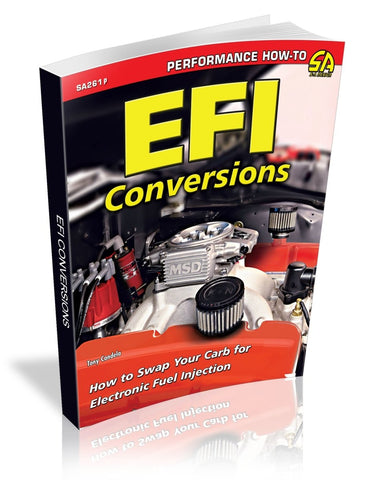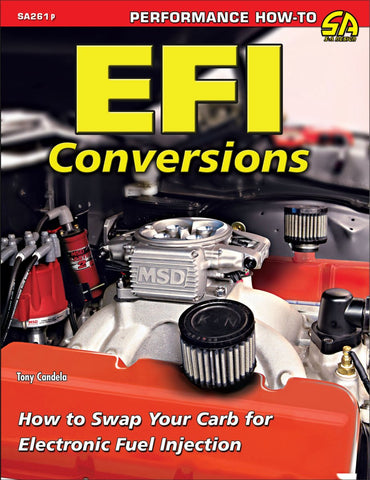Converting from a carbureted fuel system to electronic fuel injection improves the performance and driveability of any classic vehicle. EFI differs from carburetion in that the engine control unit optimizes the air/fuel ratio so the engine performs at its best at all times. Installing a complete aftermarket EFI system may seem complex, but it is within your reach by using the clear and easy-to-understand, step-by-step instructions in this book.
A variety of EFI systems are currently available: throttle-body injection, multiport fuel injection, stack systems, application-specific systems, and special application systems. Author Tony Candela reveals the attributes of each so you can select the one that's ideal for your car. He shows you how to install TBI and MPFI systems as well as a complete rework of an improperly installed and poorly functioning EFI system. He also explains each crucial step for calibrating these systems in your own garage. You learn how to optimize your electrical and fuel delivery system as well as integrate ignition and computer control with aftermarket EFI systems.
A well-installed and well-tuned EFI system greatly improves the performance of a classic V-8 or any engine because the system delivers the correct fuel mixture for every operating condition. Your engine will deliver quicker starts, better fuel economy, and improved and efficient performance. With this book, achieving all these benefits is at your fingertips.
Introduction
Chapter 1:
Injection System
Air Quality
Carburetor Limitations
Air/Fuel Ratio
Carburetors versus EFI
OEM Conversions
Electronic Fuel Injection Components
Aftermarket Systems
Option Considerations
Chapter 2:
Choosing the Right System
Parts Combination Compatibility
Fuel System Requirements
Ignition System Requirements
Electrical System Requirements
Properly Planning an EFI Installation
Chapter 3:
EFI Tuning Basics
Air/Fuel Ratio
Ignition Timing
Operating Mode and Sensors
Drivability Tuning
Tuning Tools of the Trade
Power Adders
Tuning with Power Adders
Chapter 4:
Holley HP EFI System Installation
Drivability
Diagnosing EFI Running Problems
14-Volt Battery Conversion
Fuel Pump Speed Controller Installation
Volt Meter Upgrade
14-Volt Battery Installation
Low-RPM Rev Limiter Interface
Wideband A/F Gauge Installation
Chapter 5:
MSD Atomic System Installation
System Advantages
System Aspects
MSD Atomic EFI System Installation
Stage One: Add EFI, Utilizing the Existing Ignition System
Stage Two: Add Complete Engine Management
Chapter 6:
Holley Dominator System Installation
Define Your Objective
Component Selection
Holley Dominator System Installation
Stage One: Pre-Installation
Stage Two: Electrical and Fuel Systems
Stage Three: Holley Dominator Components
Stage Four: Get It to Run
Ignition Timing
Idle Calibration
The Victory Lap
Chapter 7:
Fine-Tuning the Holley Dominator System
Fuel Mixture
Drive It
Putting the Power of the ECU to Work
Electrical Interface Changes
Building a Vehicle-Specific EFI Harness
Epilogue
Source Guide
Converting from a carbureted fuel system to electronic fuel injection improves the performance and driveability of any classic vehicle. EFI differs from carburetion in that the engine control unit optimizes the air/fuel ratio so the engine performs at its best at all times. Installing a complete aftermarket EFI system may seem complex, but it is within your reach by using the clear and easy-to-understand, step-by-step instructions in this book.
A variety of EFI systems are currently available: throttle-body injection, multiport fuel injection, stack systems, application-specific systems, and special application systems. Author Tony Candela reveals the attributes of each so you can select the one that's ideal for your car. He shows you how to install TBI and MPFI systems as well as a complete rework of an improperly installed and poorly functioning EFI system. He also explains each crucial step for calibrating these systems in your own garage. You learn how to optimize your electrical and fuel delivery system as well as integrate ignition and computer control with aftermarket EFI systems.
A well-installed and well-tuned EFI system greatly improves the performance of a classic V-8 or any engine because the system delivers the correct fuel mixture for every operating condition. Your engine will deliver quicker starts, better fuel economy, and improved and efficient performance. With this book, achieving all these benefits is at your fingertips.
Introduction
Chapter 1:
Injection System
Air Quality
Carburetor Limitations
Air/Fuel Ratio
Carburetors versus EFI
OEM Conversions
Electronic Fuel Injection Components
Aftermarket Systems
Option Considerations
Chapter 2:
Choosing the Right System
Parts Combination Compatibility
Fuel System Requirements
Ignition System Requirements
Electrical System Requirements
Properly Planning an EFI Installation
Chapter 3:
EFI Tuning Basics
Air/Fuel Ratio
Ignition Timing
Operating Mode and Sensors
Drivability Tuning
Tuning Tools of the Trade
Power Adders
Tuning with Power Adders
Chapter 4:
Holley HP EFI System Installation
Drivability
Diagnosing EFI Running Problems
14-Volt Battery Conversion
Fuel Pump Speed Controller Installation
Volt Meter Upgrade
14-Volt Battery Installation
Low-RPM Rev Limiter Interface
Wideband A/F Gauge Installation
Chapter 5:
MSD Atomic System Installation
System Advantages
System Aspects
MSD Atomic EFI System Installation
Stage One: Add EFI, Utilizing the Existing Ignition System
Stage Two: Add Complete Engine Management
Chapter 6:
Holley Dominator System Installation
Define Your Objective
Component Selection
Holley Dominator System Installation
Stage One: Pre-Installation
Stage Two: Electrical and Fuel Systems
Stage Three: Holley Dominator Components
Stage Four: Get It to Run
Ignition Timing
Idle Calibration
The Victory Lap
Chapter 7:
Fine-Tuning the Holley Dominator System
Fuel Mixture
Drive It
Putting the Power of the ECU to Work
Electrical Interface Changes
Building a Vehicle-Specific EFI Harness
Epilogue
Source Guide










